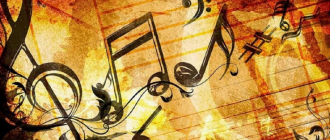If you want to learn how to play the C major scale and understand how it is formed on the staff as well as its relative minor scale, here in this post I teach it to you.
First we will see what is a major scale with its tones and semitones, then we will build the C major scale in ascending, descending and two octaves, then we will check how to play it in tablature, we will see the chords that this scale has and finally I will show you how to form the relative minor scale of DO, that is, the scale of A minor.
What is a major scale?
A major scale is a scale consisting of seven notes whose notes go by joint degrees on the staff. It can be played ascending or descending.
The major scale, like all diatonic scales, consists of a combination of tones and semitones (the distance between adjacent notes). In the following image you will see that the tones are marked with a T and the semitones with an S.
C major scale with Tones and Semitones:

All major scales, as well as the C scale, have this same structure of tones and semitones, that is to say:
Tone- Tone- Semitone- Tone- Tone- Tone- Tone- Semitone
How is the C major scale constructed?
To build the C major scale, the first thing to do is to write the note DO. This note is below the first line of the staff and another line is added on top of it. This added line is called an additional line.

The C major scale on the stave
Once you add the DO note, the rest is easy. Just draw one note in front of the other, alternating line and space.
Ascending scale:

Descending scale:
This scale can also be played descending. It is written in the same way but starting from the highest note to the lowest note:

Scale with two octaves
First of all we must understand that an octave is a succession of eight notes as in the case of Do- Re- Mi- Fa- Sol- La- Si- Do. That we have eight consecutive notes.
Two octaves refers to a wider range that goes from one note from where we start, in this case DO, to playing the scale twice, that is, repeating the notes but in another higher or lower range. Here is an example:

How to read the C scale in tablature? tablature
The C scale can also be read in tablature. If you are a beginner you should know that there are different positions where you can do this same scale. However you don’t have to learn all of them, just the first one:
C scale in first position

Scale from fret 3 string 5

From eighth fret of string 6:

These three positions that I have given as an example all sound the same, if you look at the staff, the notes are the same. If you want to learn all the positions of the major scale I recommend you visit this post.
Scale chords
The C major scale can also be harmonized.
The C scale and its relative minor
All major scales have a key that is relative minor. This means that it is a minor scale containing the same notes but in a different interval order:
C scale: C-E-E-E-E-E-G-G-G-E-E-B
A minor scale: A-E-B-E-D-O-R-E-E-E-E-G
To find out the relative minor scale of a major scale, in this case the scale of A natural minor, we have to count three notes backwards, that is, the relative minor scale of C is a third away:

We would start the scale from the note A until we reach its octave:

Exercises to practice the C scale
And now it’s time for you to play this scale in different ways. First playing it ascending, then descending, then with two octaves ascending and descending and finally with some exercises. Here they are:
I hope this lesson has been helpful. If you have any questions, write them in the comments.






